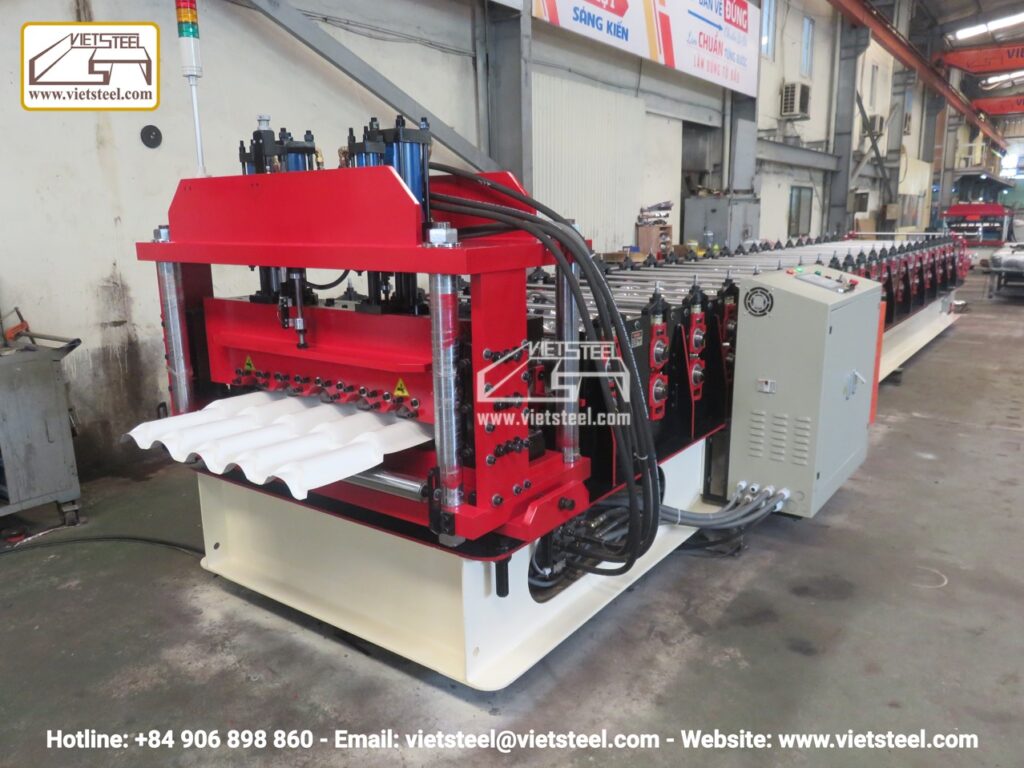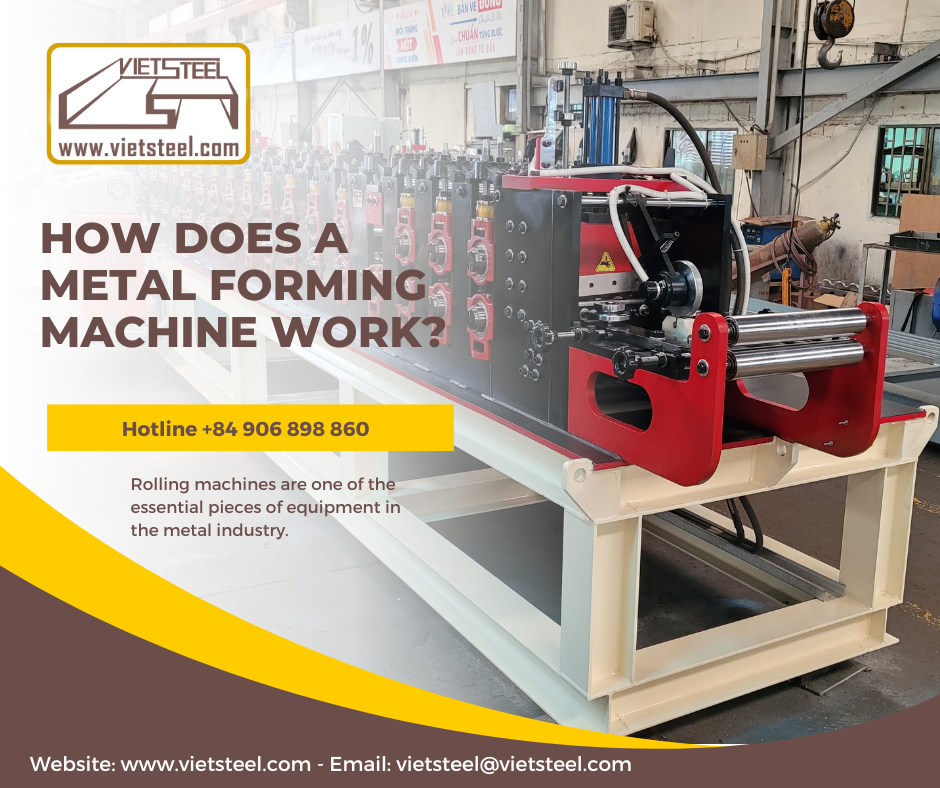What is a metal forming machine?

A metal rolling machine, also known as a metal shaping roll forming machine, is one of the essential devices in the metal industry. Its primary function is to transform the shape of long metal strips, often from rolled steel, to create specific components with desired shapes and dimensions according to the design.
Most metal rolling machines operate in a continuous cycle. The material is fed into the machine, where it continuously goes through various stages, culminating in the completion of the final product.
How does a metal rolling machine operate?
A metal rolling machine accomplishes the task of bending metal by passing it through a series of fixed rollers with shaping and guiding functions, shaping the metal according to the design. Each roller serves a specific function. As the metal strip moves through the shaping machine, each set of rollers slightly bends the metal more than the previous set.
This progressive metal bending method ensures precise cross-sectional configurations while maintaining the cross-sectional area of the metal sheet (sheet metal). Typically, rolling machines operate at speeds ranging from 20 to 60 meters per minute. Metal rolling machines are an excellent choice for large-scale production for businesses investing in rolling machinery. The results often yield intricately shaped, high-quality, and well-finished products.
Basic Concepts of Metal Shaping Rolling Machines and the Shaping Rolling Process
Basic Concepts of Metal Shaping Rolling Machines and the Shaping Rolling Process
A basic metal rolling machine consists of a production line that can be divided into four main parts. The first part is the feeding section, where materials are loaded. Materials are typically fed in the form of sheets or supplied from a continuous coil. Due to the continuous nature of the operation, materials are fed into the uncoiler to ensure a swift rolling process. The next part involves the rolling wheels at various stations, where the actual rolling and shaping of the metal occur, and where the metal takes on its desired shapes during this process. The rolling wheels at different stations not only shape the metal but also serve as the main driving force of the machine to create specific configurations for each machine type.
The next part of the basic metal shaping rolling machine is the cutting machine, where the metal is cut to a predetermined length. Due to the continuous operation speed of the machine, the cutting technique does not affect the final rolling results. The final part is the exit station, where the finished product is discharged onto a conveyor belt or support table, or it may be manually moved.
The Evolution of Metal Rolling Machines
Modern metal rolling machines feature user-friendly designs supported by touch-screen control panels. By incorporating PLC and HMI systems, rolling machines operate at maximum efficiency, making it convenient for order initiation and automatic operation.
In many modern metal shaping rolling machines, the logic control system ensures precision. This is crucial when a part requires numerous holes or needs to be cut to specific lengths. Some metal rolling machines also have the capability for laser welding or TIG welding. Integrating these options into the machine reduces the manual labor required in the metal shaping rolling process.
Tolerance in Metal Shaping Rolling
The tolerance in the size of a component produced through metal rolling depends on the type of material used, the rolling equipment, and real-world applications. Tolerance can be influenced by variations in the thickness or width of different metals, the elasticity of materials during the production process, the quality and wear of tools, the actual machine condition, and the operator’s level of experience.
Benefits of Metal Rolling Machines
In addition to the benefits discussed earlier, metal rolling machines offer users specific advantages. Metal rolling machines are energy-efficient because they do not require energy to heat the material—the metal shapes are formed at room temperature.
Metal shaping is an adjustable process and can be applied to projects with varying timeframes. Furthermore, metal shaping provides a consistent and precise metal detail.
Some Typical Types of Metal Shaping Rolling Machines
1. Corrugated Metal Rolling Machine

A corrugated metal rolling machine is a specialized device used for shaping metal sheets into corrugated patterns, typically in the form of circular waves. These corrugated sheets are often used for roofing and walls in structures that require efficient water drainage, such as industrial warehouses, storage facilities, conference centers, hospitals, nurseries, and sports arenas. Corrugated metal rolling machines can accurately produce the desired shapes as per customer requirements.
Nowadays, corrugated metal rolling machines come with various wave patterns, including 5-wave, 7-wave, 9-wave, 11-wave, and 13-wave designs.
Advantages of Corrugated Rolling Machines:
Businesses can save time and achieve desired results with ease due to the machine’s diverse rolling speeds, high efficiency, and near-perfect precision in a short timeframe.
The cost of a corrugated metal rolling machine is reasonable, and it is fully automated, reducing the need for manual labor during operation. In the past, only one operator was required, but the product quality is still ensured.
The machine provides high productivity, producing more products in less time.
It reduces labor-intensive work for employees.
It offers the lowest cost and price point as there’s no need to hire excessive manual labor. Time and productivity are consistently maintained, resulting in revenue for businesses.
All components are imported from Japan, Taiwan, Switzerland, ensuring the quality and durability of the machine.
The cutting blade is made from SKD11 material, manufactured with precision CNC machining and heat-treated to have a hardness of 52-58HRC.
It can automatically roll and cut at any predetermined length with a preset quantity, while also providing automatic alerts before the order is completed.
The hydraulic system is equipped with a sufficient cooling system for continuous machine operation from 20 to 22 hours per day.
The machine has a high lifespan, operating continuously for 15 years with a 1-year warranty, helping businesses reduce replacement costs while maintaining stable product quality.
More information about Corrugated Metal forming machine at here
2. Trimdeck Metal Rolling Machine

Vietsteel currently offers a variety of square wave metal rolling machines with diverse designs and accurate shaping capabilities tailored to customer requirements. These machines can be configured to produce a range of sizes, including Model RF-EH, Model RF-EL, Model RF-FL, Model RF-FR, Model RF-HD, and Model RF-SE.
Advantages of Square Wave Rolling Machines:
The machines produce products with nearly absolute precision.
They operate reliably for 15 years with a 1-year warranty.
They can roll metal sheets of various thicknesses, colors, and materials according to customer orders.
High productivity in rolling square wave metal patterns within a short period.
The cost of square wave metal rolling machines is reasonable, and they do not require extensive manual labor to operate, reducing labor and insurance costs for businesses.
Clear origin and good warranty policies, with Vietsteel’s team advising on the machine model that aligns with the business’s specific needs.
These square wave metal rolling machines offer businesses the capability to create precise, customized products with efficiency and cost-effectiveness.
More information about Trimdeck metal forming machine at here
3. Step tile Metal Rolling Machine

Advantages: Step tile metal rolling machines offer outstanding durability, with the ability to function for an extended period without the need for replacement. They can produce tile profiled sheets that require minimal manual maintenance for over a decade. These sheets are resilient in various climate conditions, and the top layer can prevent the accumulation of mold and moss. Tile profiled metal sheets are lighter than concrete or clay roof tiles, more durable than asphalt shingles, easier to handle than traditional metal roofing, and aesthetically pleasing.
The machine can produce various forms of tile profiled metal sheets with different thicknesses and colors to meet diverse customer needs. Tile profiled sheets are popular due to their affordability, short manufacturing time, recyclability, and high aesthetic appeal.
The machine ensures near-perfect precision in the final product, with no gaps or misalignment of the waves between two sheets when viewed from all directions. The rolling wheels are designed to meet standards, ensuring accurate profiling without deviation. The machine is precisely designed and installed to ensure smooth operation between axes and cutting blades, avoiding sawtooth edges. It maintains stable production for 15 years with a 1-year warranty and lifelong maintenance.
More information about Step tile roll forming machine at here
4. C-Purlin Roll Forming Machine

a C-purlin roll forming machine is an industrial equipment used to produce C-purlin steel frames. The machine employs a continuous process to bend and shape metal coils into the desired C-shaped truss frames.
The process begins with the steel coil being fed into the machine, where it is first uncoiled and then passed through a series of rollers, gradually forming it into the desired C-shaped profile. As the steel moves through the machine, it is also cut to the appropriate length, and any necessary holes or grooves are punched into the metal.
C-Purlin steel frames are widely used in the construction industry to provide structural support for roofs, walls, and other building components. They are popular because they are lightweight yet sturdy, and can be quickly and easily assembled on-site. C-Purlin roll forming machines allow manufacturers to efficiently produce large quantities of C-Purlin frames with high precision, making them an essential tool for many construction projects.
C-Purlin roll forming machines are commonly used in the metal sheet manufacturing, construction, and production industries to manufacture galvanized steel truss frames. One of the key advantages of these machines is their ability to create aesthetically pleasing custom designs. Additionally, these machines have robust frames and are easy to operate, providing a stable and reliable production process. They are reasonably priced, making them a cost-effective choice for those looking to produce high-quality steel truss frames.
More information about C-Purlin Roll Forming Machine at here
Hotline: +84 906 898 860 – Email: vietsteel@vietsteel.com – Website: www.vietsteel.com
